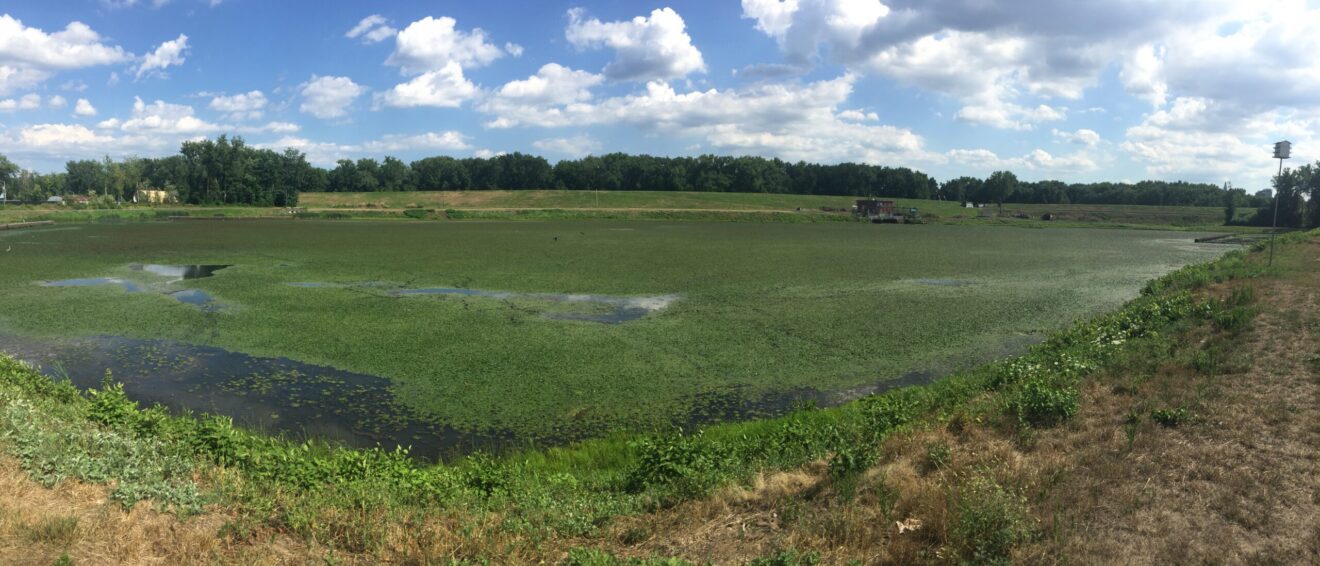Steve Gebhart has been pulling invasive water chestnuts for years, but said he had never seen anything like the mats of vegetarian he saw floating down the Connecticut River last week.
From the mouth of the Salmon River in East Haddam, down to the Middlesex Yacht Club in Chester the mats of water chestnut were so wide, Gebhart said he could hardly maneuver his small motorboat between them.
Kelsey Wentling, the Connecticut River Conservancy’s riverkeeper for Connecticut, told CT Examiner that she had heard reports up and down the river of these floating carpets of water chestnut. Wentling said she believes the vegetation came from a flood control pond in Hartford’s North Meadows, where the surface until recently had been entirely covered the invasive.
Hartford Public Works Director Michael Looney said the city did pump water from that pond into the Connecticut River on Aug. 19 to prevent the heavy rains from the remnants of Tropical Storm Fred from flooding the retention ponds. That storm poured about 5.5 inches of rain on Hartford, causing flooding in some areas of the city.
On Saturday, in preparation of more heavy rains from Tropical Storm Henri, the city used a mini-excavator to remove water chestnuts from intake racks on the pumps. As heavy rains inundated the city again on Sunday and Monday, the city had to continuously excavate water chestnuts from the intack racks to keep the water flowing through the pumps, Looney said.
Looney said city crews pulled about 30 loads of water chestnuts from the pumps during Henri, and because of the intensity of the operation and the force of the flow of water, it’s likely some of the plants were pumped into the Connecticut River.
According to Wentling that timing lines up with sightings of water chestnut downriver from Hartford on Friday and Saturday.
A “super-spreader” of invasive plants
Water chestnut is an invasive plant that has become a scourge along the coves of the Connecticut River. The plants are prolific reproducers – each individual plant can produce 15 seeds a year — and can quickly overtake calm bodies of water, forming a dense mat that can block light and stagnate the water.
According to Lyme-resident Humphrey Tyler, his organization, Friends of Whalebone Cove, has been trying to address the invasive for years. After learning that Whalebone Cove was in danger of being covered by an “impenetrable mat of vegetation,” the organization began gathering volunteers to pull the chestnuts out of Whalebone and Selden coves each summer, much as the Jonah Center and Connecticut River Conservancy have done in the Mattabassett River.
Tyler said the summer pulls are crucial because the plants begin to spread their seeds in mid-August — so pulling one plant in July could mean 15 fewer plants over the next several years. Unfortunately, Tyler warned, the timing of the Hartford release could mean thousands more water chestnut plants have been spread along the lower river.
“That pump out has become what will probably be a super-spreader event for water chestnut in the lower Connecticut River,” Tyler said. “It will probably set us back thousands of volunteer hours.”
The storage pond is part of the levee system the U.S. government constructed along the bank of the Connecticut River after the flooding of the 1930s. The government built the levees to protect Hartford from catastrophic floods like the Great Flood of 1936. The storage pond was constructed as a way to manage stormwater runoff behind the levee in the North Meadows, Looney said.
When the river is at normal levels, a series of open gates along the levee allow the stormwater to drain into the Connecticut River. But once the river exceeds 6 feet at the North Meadows pump station, water from the river and Wethersfield Cove begins to back up into the levee. When that happens, the gates have to be closed and the water has to be pumped into the river, Looney said.
Tyler said he understood that the city had to pump out the pond because of the excessive rain from two tropical storms over the last week, but said the city should have been more proactive in managing the water chestnut infestation on the pond.
Wentling said she brought the infestation to the city’s attention over a year ago, providing photos of the pond covered completely in the invasive plants. She said she brought the issue up again earlier this summer when Tropical Storm Elsa came through Connecticut, and she heard of plants coming out of the pond into the river from someone canoeing in the area.
“I think it was preventable,” Wentling said.
There’s some hope that the river has been running fast enough to pull many of the plants out into the Long Island Sound, where the salt water will kill them, but Wentling and Tyler said downriver communities will likely be dealing with the effects of the release for years.
Tyler said that after three years of volunteer pulls, they had finally come to a point where they could keep the water chestnuts in Whalebone and Selden coves from spreading and from completely blanketing the coves, but more seeds coming down the river could set them back.
“We’re going to have to organize volunteers for years to go up and down the river to find where there are new infestations from these plants that were discharged,” he said.

